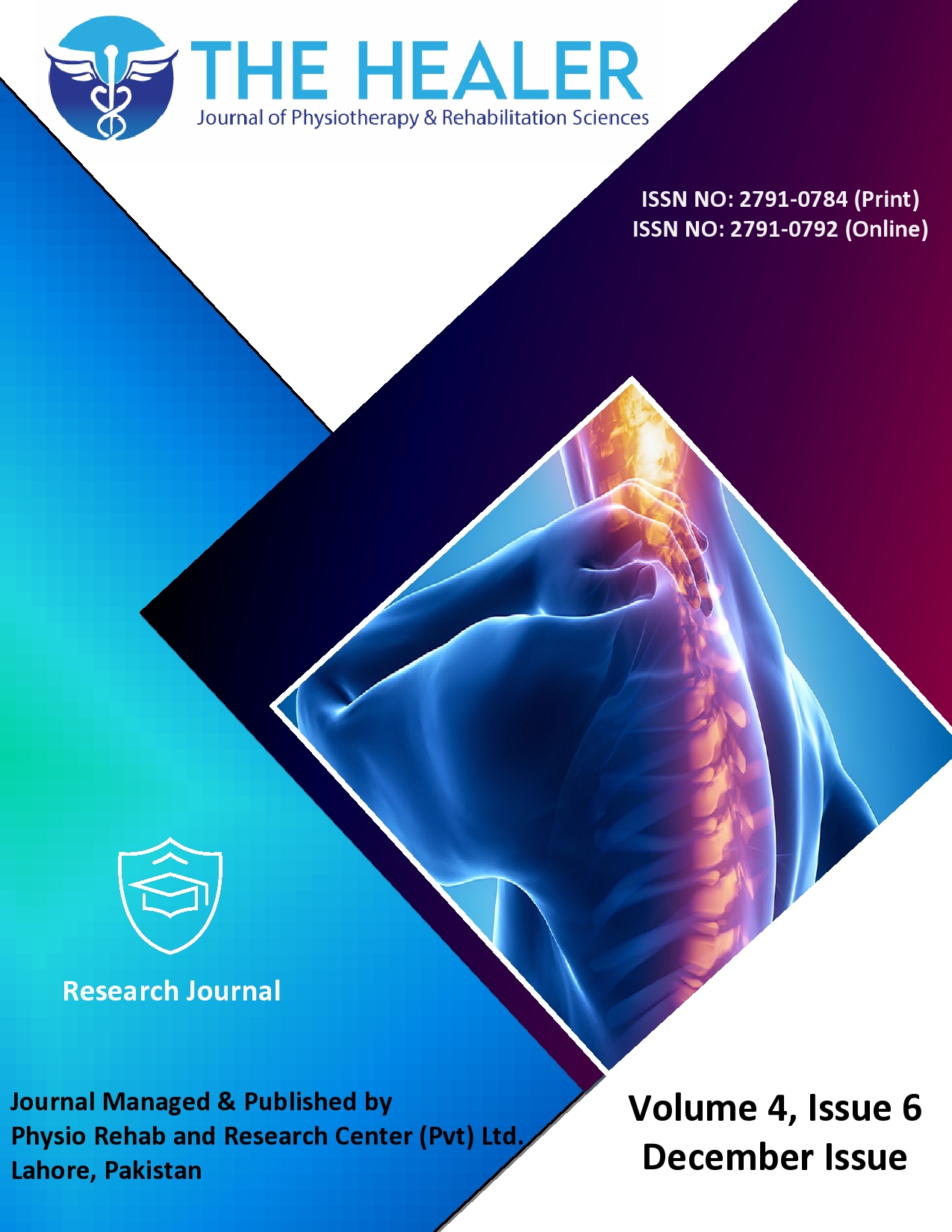Prevalence of Post-traumatic Stress Disorder and its Risk Factors Among Emergency Care Workers Following Mass Casualty Incidents
Post-traumatic Stress Disorder in Emergency Care Workers Following Mass Casualty Incidents
DOI:
https://doi.org/10.55735/hjprs.v4i6.295Keywords:
Anxiety, Depression , Emergency care workers, Risk Factors , StressAbstract
Background: Emergency care personnel are at an increased risk of developing post-traumatic stress disorder due to their frequent exposure to traumatic events. Objective: To determine the risk factors of post-traumatic stress disorder among emergency care workers following mass casualty incidents. Methodology: A cross-sectional research of emergency care professionals across many departments investigated the prevalence of post-traumatic stress disorder and associated risk factors. Medical personnel, including nurses, paramedics, and emergency medical technicians were selected by stratified random sampling. The depression, anxiety, and stress scale-21, a validated instrument, assessed symptoms, while a comprehensive questionnaire gathered demographic information, work characteristics, and health history, including chronic illnesses and mental medication usage. Logistic regression models in SPSS and R STUDIO revealed significant associations between post-traumatic stress disorder and risk factors, controlling for confounding variables. One-way ANOVA, linear regression, and multiple logistic regression were employed. Results: Chronic disease status, job experience, and shift number were significantly associated with mental health outcomes, with p-values of 0.007, 0.003, and 0.000, respectively. The use of psychotropic medication and its status also influenced mental health scores. The regression analysis revealed that designation and employment experience significantly positively influenced anxiety ratings (B=1.032, p=0.034) and exhibited negative correlations with chronic disease (B=-1.431, p=0.002) and psychotropic drug use (B=-1.406, p=0.000). Key predictors of depression included employment experience (B=0.579, p=0.017) and psychotropic drug use (B=-0.335, p=0.000), with an R² value indicating substantial variance explanation. Conclusion: Long shifts, chronic disease, and extensive working experience were strongly related to higher anxiety and depression in healthcare workers. Psychotropic pharmaceutical use, especially antidepressants and mood stabilisers, increased mental health difficulties, underlining the need for focused mental health treatments for healthcare personnel.
Downloads
References
Berger W, Coutinho ESF, Figueira I, Marques-Portella C, Luz MP, Neylan TC, et al. Rescuers at risk: A systematic review and meta-regression analysis of the worldwide current prevalence and correlates of PTSD in rescue workers. Soc Psychiatry Psychiatr Epidemiol. 2012 Jun;47(6):1001–11.
Bezabh YH, Abebe SM, Fanta T, Tadese A, Tulu M. Prevalence and associated factors of post-traumatic stress disorder among emergency responders of Addis Ababa Fire and Emergency Control and Prevention Service Authority, Ethiopia: institution-based, cross-sectional study. BMJ Open [Internet]. 2018 Jul 1 [cited 2024 Nov 5];8(7):e020705. Available from: https://bmjopen.bmj.com/content/8/7/e020705 DOI: https://doi.org/10.1136/bmjopen-2017-020705
Jonsson A, Segesten K, journal BME medicine, 2003 undefined. Post-traumatic stress among Swedish ambulance personnel. emj.bmj.comA Jonsson, K Segesten, B Mattsson Emergency medicine journal, 2003 emj.bmj.com [Internet]. [cited 2024 Nov 11]; Available from: https://emj.bmj.com/content/20/1/79.
Enazi S Al, Med AAITE, 2018 undefined. Stress and burnout among Red Crescent paramedic ambulance workers in Riyadh. pdfs.semanticscholar.orgS Al Enazi, AN AlEnzieIntegr Traum Emerg Med, 2018•pdfs.semanticscholar.org [Internet]. [cited 2024 Nov 11]; Available from: https://pdfs.semanticscholar.org/f00a/fd68134539f25603ab5a837601be80228e85.pdf
McCray L, Cronholm P, Bogner H, … JGF, 2008 undefined. Resident physician burnout: is there hope? ncbi.nlm.nih.govLW McCray, PF Cronholm, HR Bogner, JJ Gallo, RA NeillFamily medicine, 2008•ncbi.nlm.nih.gov [Internet]. [cited 2024 Nov 11]; Available from: https://www.ncbi.nlm.nih.gov/pmc/articles/PMC2903755/
West C, Huschka M, Novotny P, Jama JS, 2006 undefined. Association of perceived medical errors with resident distress and empathy: a prospective longitudinal study. jamanetwork.com [Internet]. [cited 2024 Nov 11]; Available from: https://jamanetwork.com/journals/jama/article-abstract/203249
Alanazi SZ, Abusharha A, Afsar T, Trembley JH, Razak S. The prevalence of post-traumatic stress disorder among emergency medical services personnel in Saudi Red Crescent Authority, Riyadh, Saudi Arabia. Frontiers in Psychiatry. 2024 May 8;15:1391586. Available from: https://pmc.ncbi.nlm.nih.gov/articles/PMC11109750/
Celso B, Tepas J, … BLOJ of T, 2006 undefined. A systematic review and meta-analysis comparing outcome of severely injured patients treated in trauma centers following the establishment of trauma systems. journals.lww.comB Celso, J Tepas, B Langland-Orban, E Pracht, L Papa, L Lottenberg, L FlintJournal of Trauma and Acute Care Surgery, 2006•journals.lww.com [Internet]. [cited 2024 Nov 11]; Available from: https://journals.lww.com/jtrauma/fulltext/2006/02000/Motor_Vehicle_Crash_Related_Mortality_Is.20.aspx
Petrie K, Milligan-Saville J, Gayed A, Deady M, Phelps A, Dell L, et al. Prevalence of PTSD and common mental disorders amongst ambulance personnel: a systematic review and meta-analysis. Soc Psychiatry Psychiatr Epidemiol. 2018 Sep 1;53(9):897–909. DOI: https://doi.org/10.1007/s00127-018-1539-5
Alaqeel MK, Aljerian NA, AlNahdi MA, Almaini RY. Post-Traumatic Stress Disorder among Emergency Medical Services Personnel: A Cross-sectional Study. Asian J Med Sci [Internet]. 2019 Jun 20 [cited 2024 Nov 5];10(4):28–31. Available from: https://ajmsjournal.info/index.php/AJMS/article/view/1028 DOI: https://doi.org/10.3126/ajms.v10i4.23990
Lima E de P, Assunção AÁ. [Prevalence and factors associated with Posttraumatic Stress Disorder (PTSD) in emergency workers: a systematic literature review]. Rev Bras Epidemiol [Internet]. 2011 [cited 2024 Nov 5];14(2):217–30. Available from: https://pubmed.ncbi.nlm.nih.gov/21655689/
Alanazi SZ, Abusharha A, Afsar T, Trembley JH, Razak S. The prevalence of post-traumatic stress disorder among emergency medical services personnel in Saudi Red Crescent Authority, Riyadh, Saudi Arabia. Front Psychiatry. 2024 May 8;15:1391586. DOI: https://doi.org/10.3389/fpsyt.2024.1391586
Blevins CA, Witte TK, Weathers FW. Factor structure of the Cambridge Depersonalization Scale in trauma-exposed college students. J Trauma Dissociation [Internet]. 2013 May [cited 2024 Nov 5];14(3):288–301. Available from: https://pubmed.ncbi.nlm.nih.gov/23627478/ DOI: https://doi.org/10.1080/15299732.2012.729555
Blevins CA, Weathers FW, Davis MT, Witte TK, Domino JL. The Posttraumatic Stress Disorder Checklist for DSM-5 (PCL-5): Development and Initial Psychometric Evaluation. J Trauma Stress [Internet]. 2015 Dec 1 [cited 2024 Nov 5];28(6):489–98. Available from: https://pubmed.ncbi.nlm.nih.gov/26606250/ DOI: https://doi.org/10.1002/jts.22059
Ashbaugh AR, Houle-Johnson S, Herbert C, El-Hage W, Brunet A. Psychometric Validation of the English and French Versions of the Posttraumatic Stress Disorder Checklist for DSM-5 (PCL-5). PLoS One [Internet]. 2016 Oct 1 [cited 2024 Nov 5];11(10). Available from: https://pubmed.ncbi.nlm.nih.gov/27723815/ DOI: https://doi.org/10.1371/journal.pone.0161645
Cheng P, Jasinski N, Zheng W, Yadava A, Wang L, Li L, et al. Psychometric Properties of the Primary Care PTSD Screen for DSM-5: Findings From Family Members of Chinese Healthcare Workers During the Outbreak of COVID-19. Front Psychiatry [Internet]. 2021 Sep 14 [cited 2024 Nov 5];12. Available from: https://pubmed.ncbi.nlm.nih.gov/34594246/ DOI: https://doi.org/10.3389/fpsyt.2021.695678
Bovin MJ, Marx BP, Weathers FW, Gallagher MW, Rodriguez P, Schnurr PP, et al. Psychometric properties of the PTSD Checklist for Diagnostic and Statistical Manual of Mental Disorders-Fifth Edition (PCL-5) in veterans. Psychol Assess [Internet]. 2016 Nov 1;28(11):1379–91. https://pubmed.ncbi.nlm.nih.gov/26653052/ DOI: https://doi.org/10.1037/pas0000254
Embriaco N, Papazian L, Kentish-Barnes N, Pochard F, Azoulay E. Burnout syndrome among critical care healthcare workers. Curr Opin Crit Care. 2007 Oct;13(5):482–8. DOI: https://doi.org/10.1097/MCC.0b013e3282efd28a
https://pubmed.ncbi.nlm.nih.gov/17762223/
Antony MM, Cox BJ, Enns MW, Bieling PJ, Swinson RP. Psychometric properties of the 42-item and 21-item versions of the Depression Anxiety Stress Scales in clinical groups and a community sample. Psychol Assess. 1998 Jun;10(2):176–81. DOI: https://doi.org/10.1037//1040-3590.10.2.176
Jackson T, Provencio A, KBKTAJ of, 2017 undefined. PTSD and surgical residents: Everybody hurts sometimes. Elsevier. 2024 Nov 11https://www.sciencedirect.com/science/article/pii/S0002961017305627
Berger W, Coutinho ESF, Figueira I, Marques-Portella C, Luz MP, Neylan TC, et al. Rescuers at risk: a systematic review and meta-regression analysis of the worldwide current prevalence and correlates of PTSD in rescue workers. Soc Psychiatry Psychiatr Epidemiol [Internet]. 2012 Jun [cited 2024 Nov 5];47(6):1001–11. Available from: https://pubmed.ncbi.nlm.nih.gov/21681455/ DOI: https://doi.org/10.1007/s00127-011-0408-2
Jonsson A, Segesten K, Mattsson B. Post-traumatic stress among Swedish ambulance personnel. Emergency Medicine Journal [Internet]. 2003 Jan 1 [cited 2024 Nov 5];20(1):79–84. Available from: https://emj.bmj.com/content/20/1/79 DOI: https://doi.org/10.1136/emj.20.1.79
Perrin MA, DiGande L, Wheeler K, Thorpe L, Farfel M, Brackbill R. Differences in PTSD prevalence and associated risk factors among World Trade Center disaster rescue and recovery workers. American Journal of Psychiatry [Internet]. 2007 Sep [cited 2024 Nov 5];164(9):1385–94. Available from: https://psychiatryonline.org/doi/10.1176/appi.ajp.2007.06101645 DOI: https://doi.org/10.1176/appi.ajp.2007.06101645
Li X, Li S, Xiang M, Fang Y, Qian K, Xu J, et al. The prevalence and risk factors of PTSD symptoms among medical assistance workers during the COVID-19 pandemic. ElsevierX Li, S Li, M Xiang, Y Fang, K Qian, J Xu, J Li, Z Zhang, B WangJournal of psychosomatic research, 2020 https://www.sciencedirect.com/science/article/pii/S0022399920308321 DOI: https://doi.org/10.1016/j.jpsychores.2020.110270
Darensburg T, Andrew ME, Hartley TA, Burchfiel CM, Fekedulegn D, Violanti JM. Gender and age differences in posttraumatic stress disorder and depression among buffalo police officers. Traumatology (Tallahass Fla). 2006;12(3):220–8. DOI: https://doi.org/10.1177/1534765606296271
Glaesmer H, Brähler E, … HGP, 2011 undefined. The association of traumatic experiences and posttraumatic stress disorder with physical morbidity in old age: a German population-based study. https://journals.lww.com/psychosomaticmedicine/fulltext/2011/06000/the_association_of_traumatic_experiences_and.7.aspx
Marcomini I, Agus C, Milani L, Sfogliarini R, Bona A, Castagna M. COVID-19 and post-traumatic stress disorder among nurses: a descriptive cross-sectional study in a COVID hospital. La Medicina del lavoro. 2021;112(3):241. https://pmc.ncbi.nlm.nih.gov/articles/PMC8223933/ DOI: https://doi.org/10.23749/mdl.v112i3.11129
Robinson HM, Sigman MR, Wilson JP. Duty-related stressors and PTSD symptoms in suburban police officers. Psychol Rep. 1997;81(3):835–45. DOI: https://doi.org/10.2466/pr0.1997.81.3.835
Kheramin S, ISIRC, 2019 undefined. Prevalence of PTSD symptoms among Iranian red crescent disaster workers participated in rescue and collection operation of the tehran-yasuj airplane crash. search.proquest.comS Kheramin, I Shakibkhah, M AshrafganjooieIranian Red Crescent Medical Journal, 2019 https://search.proquest.com/openview/e84f5bed1dbeafa2136394b166e58fcd/1?pq-origsite=gscholar&cbl=105757
Clohessy S, Ehlers A. PTSD symptoms, response to intrusive memories and coping in ambulance service workers. British Journal of Clinical Psychology. 1999 Sep;38(3):251–65. DOI: https://doi.org/10.1348/014466599162836
Alghamdi M, Hunt N, 5 STJTSDT, 2016 undefined. Prevalence rate of PTSD, depression and anxiety symptoms among Saudi firefighters. core.ac.ukM Alghamdi, N Hunt, S ThomasJ Trauma Stress Disor Treat 5, 2016•core.ac.uk [Internet]. [cited 2024 Nov 11]; Available from: https://core.ac.uk/download/pdf/76974799

Downloads
Published
License
Copyright (c) 2025 The Healer Journal of Physiotherapy and Rehabilitation Sciences

This work is licensed under a Creative Commons Attribution 4.0 International License.














